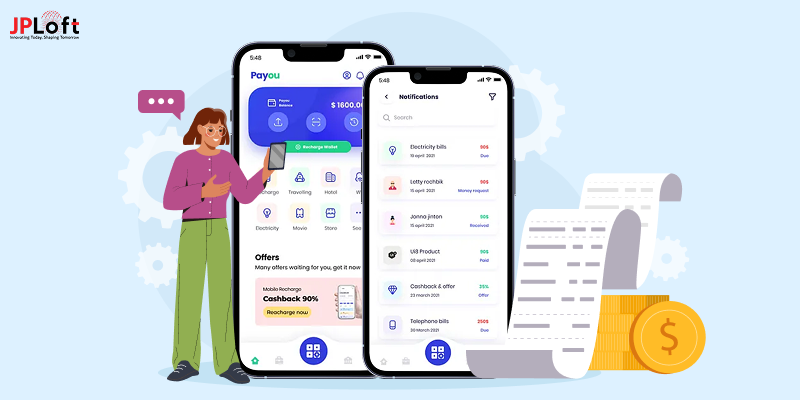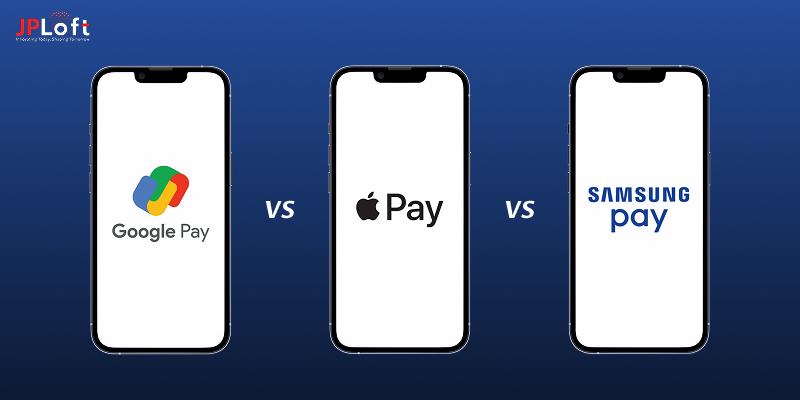Key Takeaways:
eWallets aren’t the future–they’re the present. Integrating one now means tapping into the $10+ trillion digital payment wave before competitors catch up.
Security drives loyalty. A well-executed eWallet integration with encryption, tokenization, and AI-powered fraud detection keeps users confident and returning.
Smart integration saves costs. Knowing the real cost to develop an eWallet app helps balance innovation with ROI while avoiding unnecessary expenses.
User experience wins every time. A fast, intuitive payment flow makes your app stickier and increases overall engagement and conversions.
Partnering with experts matters. Working with a seasoned team like JPLoft ensures you integrate eWallet in your app seamlessly and securely.
You’ve already built something great, but are you tapping into the $10+ trillion global digital wallet transaction market?
Seriously, your customers are ready for this!
An e-wallet feature in your existing app isn't just a cool add-on; it's the new standard for a friction-free experience.
Think about this: Digital wallets now account for over 50% of global online transactions, more than credit cards, debit cards, and cash combined!
By integrating an e-wallet, you immediately tap into that preference, making your app the one-stop shop for everything they need.
It's all about increasing your transaction volume, boosting loyalty, and making the checkout process so fast, they'll never want to leave your ecosystem.
Ready to join the mobile revolution and give your users the payment simplicity they crave?
Why is Integrating an E-Wallet Essential For Your App?
Do you want to integrate an e-wallet in your app? If you are confused, this is a section of help.
Here are a few reasons why it’s essential for your app’s success:
1. Provide a Convenient Payment Solution
Let’s face it users today want convenience.
By adding a payment gateway to your existing app, you make it easier for users to make transactions without ever leaving the app.
This smooth, cashless experience enhances satisfaction and keeps users coming back.
2. Improve User Retention and Engagement
When you integrate a digital wallet app, you’re offering something that keeps users coming back: the ability to make quick, easy payments for services or products.
It’s simple, but effective. The more your app makes life easy, the more users will stick around.
3. Open Up New Revenue Streams
Integrating mobile wallet features gives you the ability to offer in-app purchases, subscriptions, and even ads within the eWallet interface.
If you're looking to create an eWallet app, this means more ways to generate revenue and turn your app into a profitable business.
4. Enhance Security and Trust
Security is top of mind for users today.
A secure mobile wallet integration offers features like encryption, two-factor authentication, and tokenization, all of which protect sensitive data.
Building trust through robust security features will make users more likely to engage with your app.
5. Stay Competitive in a Growing Market
If you’re planning to start an online eWallet business, getting ahead of the curve is key.
Digital wallets are no longer just a nice-to-have feature; they're becoming essential.
By integrating one into your app now, you’re positioning yourself ahead of competitors who may be waiting too long to catch up.
6. Offer a Global Reach
Whether you want to add a payment gateway to your existing app or create a new one, integrating a digital wallet allows you to cater to global users.
eWallets are used worldwide, making it easier to attract international customers and expand your reach without worrying about currency exchange or transaction hassles.
So, this is why integrating an e-wallet feature is essential for your app. Get to know these considerations before integrating the e-wallet feature.
Key Considerations Before Integrating the E-wallet
So, you’re thinking about adding a digital wallet to your app? Great choice!
Mobile wallet integration is a game-changer when it comes to enhancing user experience and expanding your app’s functionality. But before you dive in, there are a few key things to keep in mind to make sure the process goes smoothly.
Let’s walk through some of the most important factors to consider.
1] Security Comes First
When it comes to digital wallet integration in an existing app, security should always be your number one priority.
You’re dealing with sensitive financial data, so you need to make sure everything is locked down tight.
Think encrypted transactions, secure authentication methods, and ewallet app compliance with regulations like PCI-DSS.
If you get security right, users will feel safe and confident using your app to store and transfer money. Trust is everything in the world of digital wallets.
2] Keep It User-Friendly
Now, while security is crucial, your users also need an app that’s easy to use. After all, no one wants to deal with a complicated payment system.
With mobile wallet integration, focus on keeping the user experience simple and intuitive. Make the process of adding payment methods or making a transaction as smooth as possible.
The easier you make it for your users, the more likely they’ll stick around and keep using your app.
3] Payment Gateway Compatibility
When you integrate a digital wallet, you’re going to need a reliable payment gateway. This is the technology that will help process transactions securely and efficiently.
Before you get started with e-wallet integration, check if your existing payment gateway is compatible with digital wallet features.
Not all payment systems are the same, and choosing the wrong one could cause delays or errors down the line. Pick the right payment gateway, and everything will flow seamlessly for your users.
4] Multiple Payment Methods Are a Must
A one-size-fits-all approach doesn’t work in the world of digital wallets. Your users might want to add different payment methods to their wallets, like credit cards, debit cards, or bank accounts.
So, when you’re working on e-wallet integration, make sure to support a variety of payment options. This flexibility will give users more freedom and make your app more appealing to a larger audience.
5] Speed and Fees Matter
In the world of mobile wallet integration, speed is key. Users don’t want to wait around for their payments to process.
If your app takes too long to complete a transaction, people might give up and move on to another app.
At the same time, make sure you’re keeping transaction fees in check. Users love fast and cheap services. Strike the right balance between speed and cost to keep your customers happy.
6] Compatibility with Your Existing Systems
You may have an app that’s been around for a while. Integrating a digital wallet feature doesn’t have to mean overhauling everything. But your existing infrastructure needs to be able to handle the new functionality.
It’s essential to test how your current backend system will work with e-wallet integration. Make sure the transition doesn’t slow down app performance or create unnecessary complications.
7] Customer Support for E-Wallet Users
Even with the best tech, there’s always a chance that users might run into issues. Whether it’s a transaction problem, a refund request, or something else, you need to be ready to help.
Integrating an e-wallet means offering reliable customer support. Be prepared with a responsive support system to handle any questions or concerns your users might have. Providing clear, efficient customer support builds trust and keeps users loyal to your app.
8] Scalability: Prepare for Growth
If your app grows and attracts more users, your digital wallet integration will need to scale with it. The last thing you want is for the system to crash when you have a spike in users making transactions.
Consider how your wallet system will handle increased usage. From supporting more payment options to processing higher transaction volumes, your integration should be able to scale without issues.
9] Localization: Think Global
If you’re aiming for a global user base, you’ll need to think about localization.
Different regions may require different currencies, languages, or payment methods. For example, while credit cards are common in the US, mobile payments might be the norm in Asia.
Make sure your e-wallet is adaptable to local needs, ensuring users around the world can easily make payments without facing roadblocks.
So, these are some of the top key considerations. Now, let’s talk about how to integrate ewallet into your app.
Step-by-Step Guide to Integrate E-wallet Into Your App
If you're looking to integrate ewallet into your app, you're taking a step toward offering your users more convenience and flexibility in their transactions.
Whether you're adding digital payments to an existing app or building a new one, this guide will walk you through the process of integrating an e-wallet smoothly and securely.
Step 1: Understand Your Requirements and Select a Payment Gateway
Before diving into the technicalities, it's crucial to understand your app's payment needs.
Ask yourself, what features should your digital wallet offer? Do you want your app to support credit/debit card payments, mobile wallet integration, or even cryptocurrencies?
Once you’ve clarified the requirements, choose a payment gateway that aligns with your goals. Look for options that allow you to integrate digital payments in your app seamlessly while offering security and scalability.
Some popular payment providers also include features like fraud detection and multi-currency support. This is your foundation for the e-wallet feature.
Step 2; Decide on the Right E-wallet Features for Your App
Now that you’ve chosen your payment gateway, it’s time to decide on the specific e-wallet app features you want to include.
Features like balance tracking, transaction history, push notifications for payments, and peer-to-peer transfers are commonly included in successful e-wallet apps.
Think about the kind of experience you want to provide your users.
For example, integrating AI in digital payments can bring enhanced security features, predictive fraud detection, and smarter payment analytics.
These are great selling points that will keep your users engaged.
Step 3: Choose Between Third-Party Solutions or Building From Scratch
You have two main options: build your own e-wallet app or integrate a mobile wallet into your app using a third-party provider.
If you want complete control and custom functionality, building your own system might be the best way to go.
However, third-party solutions like Stripe, PayPal, or Square are faster and easier to implement if you don’t want to invest too much in development time.
Both approaches come with pros and cons. The choice depends on your goals, budget, and timeline.
If you go with a third-party solution, make sure it’s scalable and can grow with your app.
Step 4: Ensure Proper Security Measures
One of the most important aspects of any digital wallet integration is security.
Your users are trusting you with sensitive financial information, and their trust is vital for the success of your app.
Integrate industry-standard security measures like end-to-end encryption, 2-factor authentication, and tokenization to protect user data.
Many modern digital wallet apps prioritize security by including biometric authentication, such as fingerprint scanning or facial recognition, to make the payment process faster and more secure.
Always follow the latest digital wallet security practices to avoid data breaches and maintain your app's integrity.
Step 5: Test the E-wallet Feature Thoroughly
App Testing is critical when you’re implementing ewallet in your app.
Start by testing basic functionalities like transactions, balance updates, and wallet top-ups.
Don’t forget to test edge cases like insufficient funds or invalid payment methods.
Additionally, run performance testing to ensure your app can handle a high volume of transactions without slowing down.
Conduct both manual and automated tests to ensure that the integration functions smoothly across all devices and operating systems.
The goal is to deliver a seamless experience to your users, where digital payments happen effortlessly every time.
Step 6: Launch, Monitor, and Update
Once the integration is complete, it’s time to launch your app and allow users to start using the new e-wallet functionality.
However, your work doesn’t end there. Monitor your app’s performance closely for issues, user feedback, and transaction failures.
Analytics tools can help you track how well your e-wallet feature is being used and whether there are areas for improvement.
Don’t forget to regularly update your app based on feedback and emerging trends in e-wallet app ideas.
Adding new features like cross-border payments or integrating with loyalty programs can keep your app competitive.
So, this is a proper step-by-step process to integrate a digital wallet into your app. So, let’s get to know the best tools & technologies for e-wallet integration.
Best Tools & Technologies For eWallet Integration
Let’s be real, ewallet integration is what turns an average app into a money-moving powerhouse.
From payment gateways and encryption protocols to AI-driven fraud detection, the right tech stack keeps transactions instant, secure, and smooth.
Here’s a quick look at the tools that power flawless digital payment integration in an app today:
|
Category |
Tools / Technologies |
Purpose & Benefits |
Why It Matters for eWallet Integration |
|
1. Payment Gateway APIs |
Stripe, PayPal, Razorpay, Braintree |
Enables digital payment integration in an app for secure, multi-currency transactions. |
Simplifies checkout, supports global payments, and ensures fast and reliable processing. |
|
2. Blockchain Frameworks |
Ethereum, Hyperledger Fabric, Corda |
Adds decentralized transparency and eliminates intermediaries in payment transfers. |
Strengthens transaction security and builds user trust through tamper-proof ledgers. |
|
3. AI & Machine Learning Engines |
TensorFlow, PyTorch, Google AI Platform |
Enhances personalization, predicts spending patterns, and flags suspicious activity using AI in Payments. |
Provides real-time fraud detection, smarter analytics, and seamless automation. |
|
4. Cloud Infrastructure Providers |
AWS, Microsoft Azure, Google Cloud |
Offers scalable and resilient backends for high-traffic eWallet systems. |
Handles millions of transactions with low latency and global uptime assurance. |
|
5. Encryption & Security Protocols |
AES-256, SSL/TLS, Tokenization, OAuth 2.0 |
Secures sensitive financial and personal data end-to-end. |
Ensures PCI-DSS compliance and prevents unauthorized access or data breaches. |
|
6. Open Banking & API Aggregators |
Plaid, Yodlee, TrueLayer |
Connects users’ bank accounts with eWallets seamlessly. |
Enables instant fund transfers and financial data syncing between apps and banks. |
|
7. KYC & Compliance Tools |
Onfido, Trulioo, Jumio |
Automates ID verification and compliance checks across regions. |
Speeds up onboarding and keeps your app aligned with global finance regulations. |
|
8. Analytics & Personalization Engines |
IBM Watson, Google AI, Amplitude |
Uses AI in Finance to track user behavior, spending trends, and engagement. |
Improves retention through customized insights and predictive recommendations. |
|
9. Cross-Platform Development Frameworks |
Flutter, React Native, Kotlin Multiplatform |
Builds a single eWallet app for both Android and iOS. |
Reduces development time while maintaining high performance and native UX. |
|
10. Emerging & Future-Ready Technologies |
NFC, QR-based Payments, Voice Commands, Biometric Authentication |
Represents top eWallet app trends driving the next wave of digital payments. |
Delivers fast, contactless, and personalized payment experiences that users now expect. |
Now that you know the tools powering flawless eWallet integration, it’s time to focus on the part that truly builds user trust, airtight security.
Security Measures When Integrating an eWallet Into an Existing App
A powerful ewallet security integration does more than encrypt data; it protects every user interaction and transaction from invisible threats.
When you blend the right security stack with smart architecture, you build not just trust, but loyalty.
Here’s how to integrate an e-wallet in an app:
► End-to-End Encryption (E2EE)
Encryption transforms all user and payment data into unreadable code during transmission. Even if hackers intercept the data, they can’t decode it.
Every card detail, account credential, or personal ID stays shielded inside a secure digital tunnel.
Why it matters: Encryption guarantees privacy and builds user confidence. It prevents data leaks and ensures transactions remain untouchable from outside interference.
► Tokenization
Tokenization swaps real card numbers for unique, random tokens that mean nothing outside a single transaction. If attackers try to grab them, they’re useless because no actual data is ever stored or shared.
Why it matters: It removes sensitive data from the network entirely, making large-scale breaches nearly impossible and ensuring transactions are always protected.
► Two-Factor & Biometric Authentication
Passwords alone don’t cut it anymore. Adding fingerprints, face ID, or one-time passcodes provides that second verification layer needed for secure access. Even if credentials are stolen, the attacker can’t proceed without the user’s physical identity.
Why it matters: Multi-factor verification stops unauthorized access cold, significantly reducing the chances of account takeovers or identity theft.
► PCI-DSS Compliance
Following global payment security standards like PCI-DSS ensures your eWallet handles sensitive data correctly. It covers encryption, firewalls, data monitoring, and access controls — all essential for financial-grade security.
Why it matters: Compliance proves your app is trustworthy and responsible. It reassures users, payment partners, and regulators that your platform meets top-tier protection norms.
► Secure API Communication
APIs are the backbone of digital payments, connecting eWallets to banks and gateways. Using HTTPS, OAuth 2.0, and signed requests ensures those bridges stay protected.
For startups, adopting wallet-as-a-service solutions can simplify secure API handling while maintaining compliance with all financial standards.
Why it matters: Securing your APIs prevents data hijacking and fake requests, maintaining the integrity of every payment flow within your system.
► AI-Powered Fraud Detection
Artificial intelligence constantly analyzes user patterns, transaction behavior, and device locations to detect anomalies before they become threats. It spots suspicious logins or payments instantly, reducing manual monitoring efforts.
Why it matters: AI adds a proactive defense line, predicting and preventing fraud in real time, saving your business money and protecting your users effortlessly.
► Regular Security Audits & Penetration Testing
Conducting regular security reviews and ethical hack tests uncovers vulnerabilities early. Audits check if encryption, APIs, and compliance standards are working as intended.
Why it matters: Staying proactive prevents exploitation. You can patch weaknesses before hackers find them, keeping the system one step ahead of every new threat.
► Data Masking & Access Control
Not every employee or system needs access to sensitive information. Data masking hides confidential details, while access control ensures only authorized users can view or modify financial records.
Why it matters: This minimizes insider threats and accidental exposure. Proper access segmentation adds another invisible wall against unauthorized tampering.
► Backup & Disaster Recovery
A secure eWallet should have encrypted backups and a fast recovery plan in case of crashes or cyberattacks. It ensures data can be restored without loss or corruption.
Why it matters: It safeguards both your users and your business reputation. No matter what happens, service continuity stays intact and downtime remains minimal.
► User Education & Real-Time Alerts
Teach users to recognize phishing attempts, maintain strong passwords, and verify logins. Send alerts for new devices, suspicious activity, or large transactions. Awareness is often the best protection.
Why it matters: Educated users become part of your security network. By involving them, you lower fraud risks and improve overall trust in your eWallet ecosystem.
With robust security measures in place, the next big question is, how much does it actually cost to integrate an eWallet into your app? Let’s break down the numbers.
Cost Breakdown of Integrating E-Wallet Into Your App
As you know, understanding the cost to develop an e-wallet app is important before getting into development.
The total investment depends on multiple factors: design, technology stack, integrations, and the level of security you plan to implement.
A simple wallet with basic payment features costs less, while advanced apps with AI-based fraud detection, blockchain, and multi-currency support can raise the budget.
Development cost also changes with the platform (Android, iOS, or cross-platform), regional regulations, and third-party integrations.
To help you plan smartly, here’s a complete breakdown that shows where your budget actually goes when building an eWallet solution designed for scalability, security, and user satisfaction.
|
Component |
Estimated Cost (USD) |
Description |
|
UI/UX Design |
$3,000 – $8,000 |
Custom app design and user journey flow |
|
Core Development |
$10,000 – $25,000 |
Backend logic, APIs, and payment handling |
|
Payment Gateway Integration |
$5,000 – $10,000 |
Linking Stripe, PayPal, or Razorpay gateways |
|
Security & Encryption |
$7,000 – $15,000 |
Data protection, PCI-DSS compliance, fraud detection |
|
Testing & QA |
$2,000 – $5,000 |
Functional, performance, and load testing |
|
Maintenance |
$1,000 – $3,000/month |
Regular updates and bug fixes |
|
Total Estimated Cost |
$30,000 – $85,000+ |
Now that you know where your budget goes, it’s time to look at the road ahead, the real-world challenges businesses face during eWallet integration, and how to overcome them.
Common Challenges in E-Wallet Integration and How to Overcome Them
The biggest challenge in eWallet integration lies in balancing innovation with reliability.
As businesses race to integrate e-wallets into their app, even small oversights in scalability, compliance, or user trust can cause major setbacks.
Here’s how to anticipate these hurdles and turn them into growth opportunities.
1. Security Breaches and Data Theft
Financial data is gold for hackers, and weak encryption exposes user transactions.
Solution: Use AES-256 encryption and tokenization to protect data. Regular audits and real-time threat detection keep your mobile wallet integration safe and compliant.
2. Payment Gateway Conflicts
Multiple gateways can clash, leading to failed or delayed transactions.
Solution: Test all payment APIs in sandbox mode before launch. Partnering with experienced mobile app development companies ensures smooth syncing and reliable performance when you implement a mobile wallet into your app.
3. Cross-Platform Compatibility
An eWallet that works on Android but glitches on iOS kills user confidence.
Solution: Build using cross-platform frameworks like Flutter or React Native to maintain consistency across devices and platforms.
4. Compliance and Regulatory Barriers
Global transactions require strict adherence to local data and banking laws.
Solution: Stay PCI-DSS compliant and integrate built-in KYC verification systems to maintain transparency and trust with users.
5. Poor User Experience
Even the most secure app fails if it’s not intuitive to use.
Solution: Focus on clean design, one-tap payments, and instant notifications. Regular usability testing ensures your app feels effortless and secure to users.
So, with challenges being done. Let’s talk about experts who can help you with e-wallet integration.
How JPLoft Can Help You With E-Wallet Integration?
Here’s the thing integrating an eWallet isn’t just about adding a payment feature; it’s about creating a faster, safer, and more connected app experience.
When you integrate eWallet in your app, you need a partner who understands security, scalability, and user behavior. That’s where JPLoft, a trusted eWallet app development company, steps in.
With years of expertise in fintech innovation, JPLoft helps you build or upgrade apps with seamless digital payment systems.
From API integration and smart UI/UX to compliance with PCI-DSS and KYC standards, the team ensures your wallet feature is robust and future-ready.
Whether you’re starting small or scaling globally, JPLoft customizes every solution to fit your goals and market demands, ensuring your app stands out with a flawless transaction experience.
Conclusion
Integrating an eWallet feature isn’t a luxury anymore; it’s a necessity for staying relevant in the digital economy.
From choosing the right tools and ensuring airtight security to managing costs and overcoming challenges, every step plays a part in building user trust.
Partnering with experts like JPLoft can help you navigate the technical, financial, and strategic aspects effortlessly, giving your app a competitive edge in the ever-evolving fintech landscape.
FAQs
Typically, it takes 4–8 weeks, depending on features, integrations, and app complexity.
Yes, JPLoft tailors eWallet solutions for industries like retail, travel, healthcare, and on-demand services.
We use tokenization, encryption, two-factor authentication, and PCI-DSS compliance for maximum protection.
Absolutely. Our experts can integrate gateways like PayPal, Stripe, or Razorpay based on your target region.
Because we blend innovation, security, and scalability to deliver reliable payment systems that enhance user trust and business growth.













Share this blog